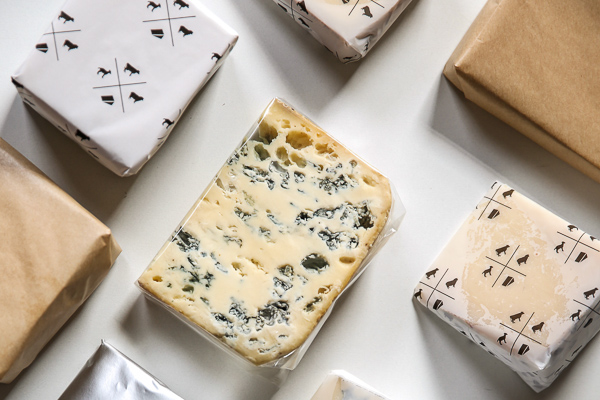I’ve been hectoring consumers for a long time about storing cheese properly at home. Make sure it can breathe. But don’t let it dry out. Do this, not that. People would ask whether they needed to buy fancy cheese paper or invest in a cheese vault, and being gadget-averse myself, I always said no. You can provide suitable storage for cheese with materials at hand, I told them. But then I spoke at length to Mark Goldman, owner of Formaticum, the cheese-paper company, and our chat has me rethinking my methods. I’ve edited the conversation for length and clarity but here’s the gist of it:
Mostly I wrap cheese loosely in wax paper so it can breathe and then put it in a lidded container for humidity, but I do occasionally use your cheese paper and cheese bags. Are they both made from the same material?
Goldman: The paper is classic French cheese packaging, made by combining a sheet of paper with a thin sheet of low-density polyethylene. This is an important distinction. All plastic is not created equal in terms of how it impacts food. Low-density polyethylene is not commonly used for food packaging because it’s not a complete barrier. Plastic food film like Saran wrap is designed to be a full barrier, but cheese doesn’t want that. Cheese needs some porosity. And the chemicals they treat that plastic with to make it stretch and stick have been shown to impact fatty foods, which act like sponges and can absorb those plasticizers. Low-density polyethylene has no flavor impact on the product it wraps. In concert with the paper, which keeps some humidity in, it works perfectly for cheese.
And the bags?
The bags are the next iteration of combining paper and plastic. Spray-coating paper with plastic is pretty common, but my supplier figured out how to apply the plastic so it’s not a complete barrier, so it still has porosity. Butcher paper is a complete barrier; it’s designed to hold bloody meat. For cheese, we want some oxygen exchange. The bag material is easier to work with than the sheets and more durable; a bag can be re-used multiple times for the same type of cheese.
Any idea how much extra life you get from storing cheese in your materials instead of plastic film?
I supplied my product to a company in Australia a couple of years ago for some shelf-study tests. They manufacture home-refrigeration units and were testing a new type of drawer with better humidity. They found that cheese kept three times longer in the bags versus plastic food film.
Once you’ve wrapped the cheese, where in the fridge should you put it?
Plastic wrap: Friend of mold, enemy of cheese
It shouldn’t make any difference. The biggest problem of most home refrigerators is that they are extremely dry. If cheese is wrapped properly in paper or a bag, that’s an ample barrier to dryness. It doesn’t need to go in a food-storage container; that’s redundant. Some people do that to keep their cheeses organized, but it doesn’t extend cheese life.
Any cheeses you don’t recommend wrapping in cheese paper?
Anything you buy in brine, like feta or fresh mozzarella, you should keep in that brine.
What happened to that material you showed me a couple of years ago made from eggshells?
It wasn’t made from eggshells but it uses calcium carbonate. We had problems with the supplier but we’re re-launching it. The next version will come on a roll with a tear strip so you can tear the size you need. The material is reusable and recyclable, and I hope to have it out for the holiday season. It keeps Parmigiano-Reggiano pretty much forever.
You obviously researched best practices before you started Formaticum in 2006, but have you learned more about cheese storage since then? Any recent epiphanies?
I’ve definitely learned a few more tricks that I practice in my home that aren’t part of packaging science. It’s always best to remove all the rind before you wrap. The rind serves no purpose. We understand why a shop wants to keep it on and divide it equally—it’s part of the weight of the cheese—but it serves as a vector for introducing molds that can colonize the paste once it’s wrapped. The rind is the biggest source of surface mold growth.
Even bloomy-rind cheeses like Brie? You remove those rinds?
If it’s a soft cheese with an edible rind, no. But I don’t like to eat other rinds. I’ve seen too much of how cheese goes through warehouses.
How about a washed-rind cheese like Taleggio? You would cut that rind off before you wrap it?
I don’t eat the rind on Taleggio. I would eat the rind on Epoisses because of the way it’s packaged; it’s been kept hermetically sealed. But larger-format cheeses that travel internationally, I shy away from eating those rinds.
What about hard cheese like Comté? You cut the rind off before you wrap it? Really?
Absolutely. On a cheese plate, people like to see the rind because it helps them understand what they’re looking at and how that cheese relates to the larger wheel. But the rind is dirty packaging and I don’t want to have a cut piece of cheese up against it. As soon as I get cheese home, I remove all the rind.
Wow. Never done that. I consider the rind part of the cheese’s identity and beauty and always tell people to leave it on. Please weigh in on this in the Comments section below, cheese pros and enthusiasts. Do you view rinds as soiled packaging that needs to go?


